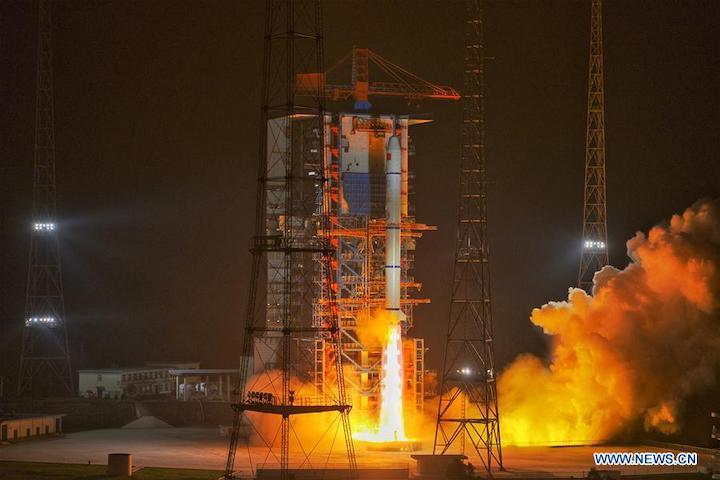27.10.2020

A Long March-2C carrier rocket blasts off from the Xichang Satellite Launch Center in southwest China's Sichuan Province on Oct. 26, 2020. China successfully sent a group of new remote-sensing satellites into orbit from the Xichang Satellite Launch Center in southwest China's Sichuan Province on Monday. Belonging to the Yaogan-30 family, the satellites were launched by a Long March-2C carrier rocket at 11:19 p.m. (Beijing Time). (Photo by Guo Wenbin/Xinhua)
China successfully sent a group of new remote-sensing satellites into orbit from the Xichang Satellite Launch Center in southwest China's Sichuan Province on Monday.
Belonging to the Yaogan-30 family, the satellites were launched by a Long March-2C carrier rocket at 11:19 p.m. (Beijing Time).
The satellites have entered the planned orbits and will be used for electromagnetic environment detection and related technological tests.
Also on board the rocket was a satellite belonging to the Tianqi constellation. The satellite, Tianqi-6, will be used for data transmission. The Tianqi constellation, developed by a Beijing-based high-tech company, is for short-message communications.
It was the 350th mission of the Long March rocket series. Enditem

A Long March-2C carrier rocket blasts off from the Xichang Satellite Launch Center in southwest China's Sichuan Province on Oct. 26, 2020. China successfully sent a group of new remote-sensing satellites into orbit from the Xichang Satellite Launch Center in southwest China's Sichuan Province on Monday. Belonging to the Yaogan-30 family, the satellites were launched by a Long March-2C carrier rocket at 11:19 p.m. (Beijing Time). (Photo by Guo Wenbin/Xinhua)
China launches three military spy satellites
Three mysterious payloads widely believed to be signals intelligence satellites for the Chinese military rocketed into orbit on top of a Long March 2C booster Monday from a launch base in southwestern China.
The three Yaogan 30-type satellites lifted off aboard the Long March 2C rocket at 11:19 a.m. EDT (1519 GMT) Monday from the Xichang space center in the Sichuan province of southwestern China. Liftoff occurred at 11:19 p.m. Beijing time, according to China’s state-run Xinhua news agency.
The China Academy of Launch Vehicle Technology, or CALT, declared the mission a “complete success” in a statement. CALT is the government-owned contractor that produced the Long March 2C rocket.
The two-stage Long March 2C rocket, fueled by liquid hydrazine and nitrogen tetroxide propellants, delivered the three Yaogan 30 satellites to a 370-mile-high (595-kilometer) orbit inclined 35 degrees to the equator, according to U.S. military tracking data.
The satellites are the seventh triplet of Yaogan 30-type spacecraft since 2017 launched on Long March 2C rockets from the Xichang facility into similar orbits. The three Yaogan 30-07 satellites launched Monday are designed for remote sensing of the “electromagnetic environment” from their orbit 370 miles above Earth, Xinhua said.
The Chinese government uses the Yaogan name for the country’s military satellites, and the Yaogan 30 family is believed to be designed for a signals intelligence mission.
Some analysts suggested the Yaogan 30 family of satellites could be testing new electronic eavesdropping equipment, or helping the Chinese military track U.S. and other foreign naval deployments. But details about the spacecraft and their missions have not been disclosed by the Chinese government.
A fourth payload hitched a ride to space on the Long March 2C rocket Monday. The small satellite, named Tianqi 6, was launched for the Beijing-based company Guodian Gaoke on a mission to provide commercial data relay services.
Quelle: SN
